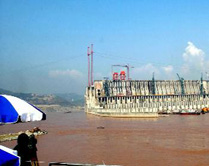 A range of measures have been introduced to ensure the Three Gorges reservoir will keep the Yangtze River flowing despite the vast volumes of silt which build up each year.
A range of measures have been introduced to ensure the Three Gorges reservoir will keep the Yangtze River flowing despite the vast volumes of silt which build up each year.
After the damming on November 6 of the man-made diversion channel built for the passage of ships during the second-phase construction of the Three Gorges Project, the natural flow of the Yangtze will be stopped.
But Yangtze water will be discharged from 22 diversion holes, each six meters wide by 8.5 meters high, on the lower part of the Three Gorges Dam.
Zhang Chaoran, engineer-in-chief of China Yangtze River Three Gorges Project Development Corporation, said that another 23 flood discharge holes in the lower part of the dam would release a large amount of silt during the annual flood season from June to September.
Each year's flood season brought 61 percent of the annual water inflow and 84 percent of annual silt in the Yangtze. From October to May, silting in the Yangtze reduces, so water could be stored for power generation and navigation, Zhang explained.
The annual average amount of silt carried into the reservoir is estimated at 530 million tons. If the problem is not solved, the normal functions of the reservoir will be affected, its life span shortened, and the river will cease to be navigable, experts warned.
Zheng Shouren, engineer-in-chief of the Yangtze River Water Resources Committee, said the discharge of floodwater and storage of cleaner water to the level of 175 meters would ensure the reservoir's long-term service, as well as guarantee power generation and navigation of the Three Gorges Dam.
The method has proved quite successful with Sanmenxia Reservoir on the Yellow River. Sanmenxia lost 62 percent of its water storage capacity in four years after it was put into service in 1960.
With the application of the method, the capacity of the reservoir has restored from 2.21 billion to 3.1 billion cubic meters and has remained at the higher level for three decades.
Simulated experiments in the past three years have proved that the method of storing cleaner water and discharging muddy water will allow the Three Gorges to retain over 90 percent of its designed capacity even after 80 to 100 years. The Chinese government made the prevention of silting a priority in the Three Gorges Project. A panel of specialists has been set up under the Committee for Construction of the Three Gorges Project under the State Council to be responsible for silt-control.
The China Yangtze River Three Gorges Project Development Corporation has granted the Yangtze River Hydrological Bureau 200 million yuan (US$24.1 million) to monitor silt removal in the reservoir until 2009 when the Three Gorges Project will be completed.
In the meantime, China has also increased investment in protecting the natural forests around the banks of the Yangtze, stepping up afforestation around the river's upper reaches and reservoir so as to control soil erosion.
Spending on water and soil preservation works in the past 13 years has exceeded 2 billion yuan (US$241 million).
The latest monitoring results prove soil erosion in the Three Gorges reservoir has been decreasing at an annual rate of 1 percent.
The State Council, the country's highest governing body, has approved plans to build large reservoirs around the Yangtze's upper reaches and its tributaries, to help reduce the amount of silt that will be swept into the reservoir.
Construction on the Three Gorges Project began in 1993. The first two phases were concentrated chiefly along the northern bank. The mainstream of the Yangtze, China's longest river, was first dammed in November 1997.
The project is expected to be completed in 2009, when 26 power-generating units with a combined capacity of 18.2 million kilowatts will go into operation. The permanent locks will also be able to accommodate ships of more than 10,000 DWT (dead weight tonnage).
The first group of four power-generating units will begin operation next year.
(Xinhua News Agency November 4, 2002)
|

